Archives
-
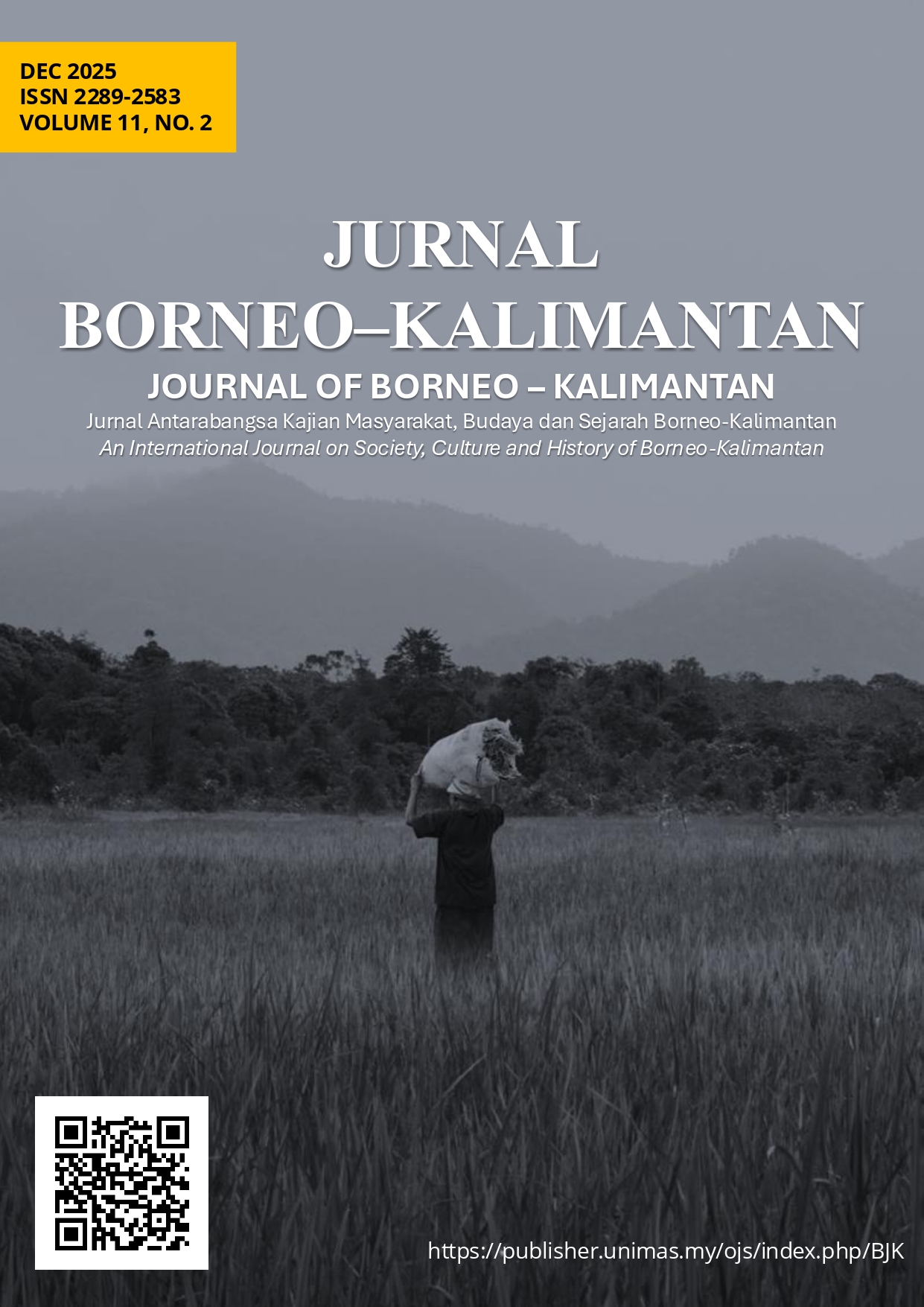
Jurnal Borneo - Kalimantan
Vol. 11 No. 2 (2025)From the Chief Editor’s Desk
Welcome to another issue of Journal of Borneo-Kalimantan (JBK).
I am pleased to introduce you to 10 articles coming from the disciplines of anthropology, international studies, linguistic, development and health science. The diversity of the articles published reflects the breadth of JBK and its commitment to extend the boundaries of knowledge relating to Borneo Studies.
There are two articles pertaining to the Penan communities in Sarawak. Benard Upieh highlights the resilience of the community in navigating and adapting with the transition from nomadic to settled life. Jayl Langub presents an ethnographic account of rivers as integral part in the Penan identity and livelihood and in connecting the kins-relation across river systems. The remaking of cultural identity remains an important framing in describing the process of cultural reconstruction. Calvin Jemarang examines the construction of Punan identity through the triangulation of multiple data sources: ethnographic, genealogy and archive, to reveal how identity construction differs from one context to another. Claudia Jiton et al observes the functional transformation in the Dayak martial arts, kuntau, from self-defence practice to artistic performance has led to the survival of kuntau as a living symbol of Iban’s identity in the modern era. Norazuna Norahim contributes to the discussion of the transformation of the Dayak culture through the function of Iban language, from the use in a community context to the formal setting, which will increase the complexity of the language. An article by Nurul Huda Marwan et al adds another dimension in the cross-border interaction in Sarawak by utilising an international relations’ perspective in examining the role played by Sarawak state as an agent of paradiplomacy in dealing with the challenges involving the movement and transaction at and across the border. The theme on indigenous health practice is explored in the three articles. Kho et al compiled the plants used by the Kenyah communities in Borneo for medicinal purpose pointed to the knowledge value of the communities. Bolhassan et al draws attention on the continuing use of traditional remedy in the midwifery practice in Sarawak, while Bo et al demonstrates the effective role of religion in promoting healthy lifestyle among its followers.
JBK is delighted to receive a collection of research notes from the Francke Foundations in Halle, Germany. The papers presented in the workshop, Out of Borneo: Provenance and Materiality of Objects from Borneo, discussed the objects and the history of collecting in reference to the Borneo objects housed in the Wunderkammer of the Francke Foundation. Readers will find the descriptions and the contexts informative especially in the current drive towards commodification of artefacts and the nationalisation of cultural identity among the nation-states in Borneo. The other contribution in the section is by Ganendra presenting an Academic Impact Magnified framework.
We thanked our contributors, reviewers, editors and readers for their incredible support to JBK in 2025. We wish you a Happy New Year 2026, and may the year brings more success to all around.
Happy reading!
Chief Editor
Editorial Team
-
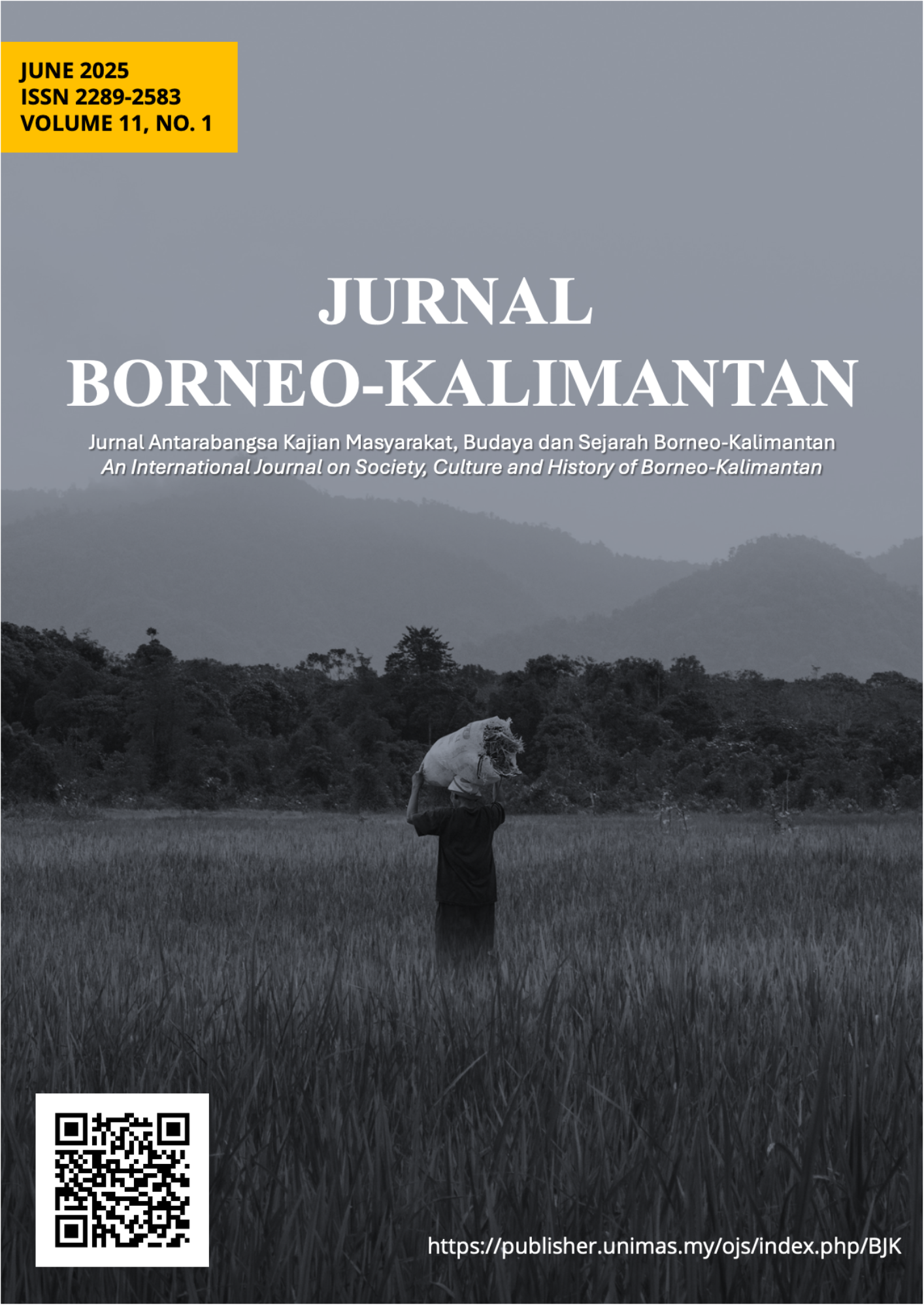
Jurnal Borneo - Kalimantan
Vol. 11 No. 1 (2025)Welcome to the latest issue of Jurnal Borneo-Kalimantan
I am pleased to welcome you to yet another exciting issue of Jurnal Borneo-Kalimantan (JBK). JBK publishes articles represent diverse writing format from research article, thinking piece and reflective practice. Being located in Borneo means that JBK celebrates heterogeneity as a way of life and also in the writings on society, experience and concerns.
There are ten articles in this issue. Dayang Hajyrayati starts off the current issue with a methodological appraisal of anthropology in her research into the statelessness in Sarawak. A paper by Juna Liau describes the context and the use of incantation by the Kenyah communities in Belaga has shed light on the continuing tradition of sacred knowledge amidst the pressure of modernization and rationalization. In a piece by Mohd Shazani the co existence of sacred tradition in modern life is presented as a forgotten, understated, a residual sentiment not given a proper place as of other forms of material and physical development. Valerie Mashman revisits the Long Jawe’ peace-making and drawn from community memory constructs the significance of the process to the cross-border interactions and relationships. Jay Langub documents the significance of river to the Penan livelihood and collective existence, a lesson which he persuasively made to communicate the importance of clean, safe and free access to ecology for the community whose life and sustenance depends on it. There are two articles from political science which drive home the value of sustainable thinking in public policy. Hisyam Basabah analyses the role Malaysia, as a chair of ASEAN in 2025, in advancing the global agenda of sustainability at the home-front and regional. Dick Lembang looks at the political thinking permeating at every level of decision-making in the use of public funds for development purpose. A study of the compilation of Berawan language by Jurgen Burkhardt highlights preservation work in the field of linguistic. Aisyah Pratiwi, et al. documents the method of paddy planting by the Kenyah community and the continuing relevance of traditional knowledge. Bernard Sellato’s article on the palaces of the sultans in Kalimantan offered an insight into how the symbolic attachment of the sultanates rejuvenated through conservation work in museology and tourism. I invite you to read the special contribution by Professor Victor King relating to his correspondence with the late Professor Rodney Needham. The letters were introduced, annotated and referenced by Professor King especially for JBK readers who will find the communication a window into the progressive history of Borneo Studies and the prolific contributions that Professor Needham played in nurturing generation of scholars researching and writing for Borneo.
Our JBK team is happy to receive your response. Do write to myself or my colleagues and share us your thought about the articles published.
Professor Dr Poline Bala
Chief Editor
-
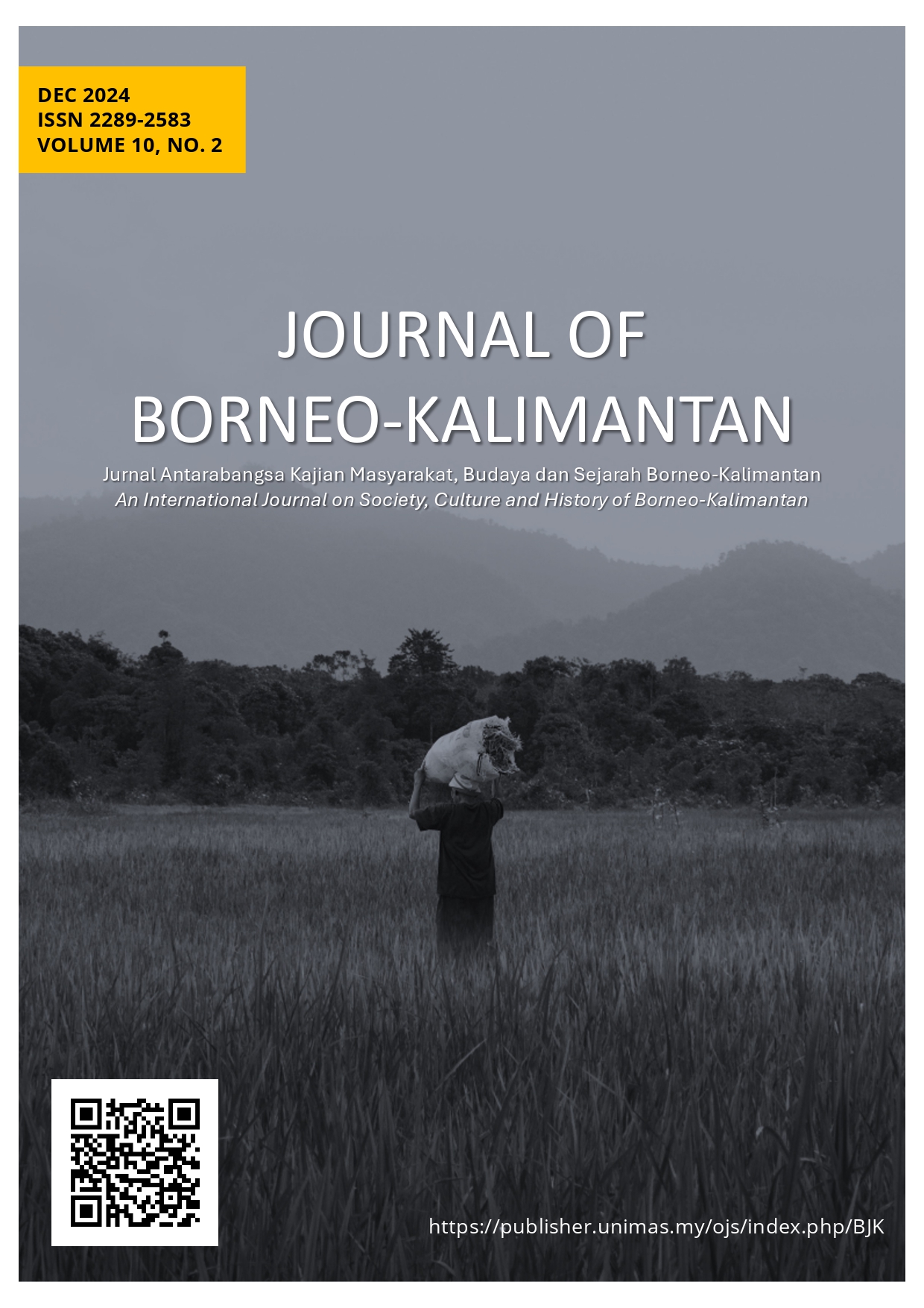
Journal Borneo-Kalimantan
Vol. 10 No. 2 (2024)Welcome to the latest edition of the Journal of Borneo-Kalimantan (JBK).
In this issue, we present to you articles showcasing the diversity of topics relating to Borneo-Kalimantan, ranging from ethnomathematics, indigenous language, development and political cultures.
The first article by Jackson Pasini Mairing et al explores the geometrical dimension in the longhouses in the Central Kalimantan. The second article, 'A Brief Linguistic Outline of Hobongan Language' is an attempt at describing a language spoken by 2000 speakers in Kalimantan. The third article by Shalini Amerasinghe Ganendra reviews the Bario Rice Project since its implementation in 2017 which highlights the implementation challenges and the socio-economic consequence to the Kelabit community. The fourth article 'Perspektif Masyarakat Kajang tentang Pelantikan Pemimpin' by Norsawani Ubau offers a unique insight into the relevance of aristocratic leadership in the age of democracy, by focusing on the perspective of the Kajang communities in Belaga, Sarawak. In particular, the article demonstrates the continuing significance of aristocracy in perpetuating the Kajang's socio-political identity which for the people represents one of the most visible heritage from a minority social group in Sarawak. The final article by Lavenne Hunyang Lemali, 'Budaya Politik Berteraskan Nilai' is an interesting article that describes the political culture of the Kayan in Belagawhich is based on religion, specifically, Christianity. The author underlines the ways in which a value-based political culture shaped the practice of politics in the community that is tolerant, non-confrontational and moderate.
We express gratitude to all the contributors for choosing JBK as the destination of your work. To our readers, have a thoughtful reading and do write to us for any feedbacks.
Happy New Year 2025!
Prof Dr Poline Bala
Chief Editor
Editorial Team
-

Journal of Borneo-Kalimantan
Vol. 10 No. 1 (2024)Welcome to Volume 10, Issue 1 of the Journal of Borneo Kalimantan!
We are excited to invite you to explore some of the scholarly works that delve into diverse aspects of Borneo Island which cover its history, cultural dynamics, and contemporary challenges. Karubi, in his article “The Bidayuh Cultural Identity 'Issues' of the Progeny of Mixed Marriages”, addresses a cultural issue in examining the complexities faced by individuals of mixed heritage within the Bidayuh community.
Meanwhile, Shariman, Mas'ud, Tarmizi, Zen, and Phang offer insights into the impact of computational thinking on educational outcomes across different subject areas in Sarawak in "Assessing the Influence of Computational Thinking Technique on STEM-Based and Non-STEM Based Subjects in Sarawak Schools”, whilst Jayl Langub delves into land rights in "Native Customary Rights Land: Indigenous Perspectives," providing an analysis of indigenous viewpoints on land ownership and usage. Marla Perkins, meanwhile, explores linguistic aspects in "Colors, Sounds, Rivers: Descriptive Terms and Informational Priority In Hobongan," offering an in-depth look at how descriptive terms reflect informational priorities within the Hobongan community.
In this issue, there are two book reviews by Ahi and Masri. Ahi reviews “Parenting on Sexuality by Razitasham Safii”, offering a critical perspective on this important work. In addition, Masri reviews "Countering the Western Canon: Other Ways of Knowing About Journalism and Media by Ahmad Murad Merican,” thus presenting an evaluation of the book's contribution to media and journalism studies.
We believe these contributions have showcase continuous and potential academic inquiry in Borneo Kalimantan context. We express gratitude to all the authors who have continuously shared their expertise and insights with us. We hope that this issue will ignite meaningful dialogue, and inspire everyone to contribute to an inspiring, and sustainable future for Borneo Kalimantan.
Professor Dr Poline Bala
Institute of Borneo Studies
Universiti Malaysia Sarawak (UNIMAS)
-

Journal of Borneo Kalimantan
Vol. 9 No. 2 (2023)Welcome to Volume 9, Issue 2 of the Journal of Borneo Kalimantan!
In this edition, we invite you to explore a diverse range of scholarly investigations that delve into various aspects of Borneo Kalimantan. These investigations cover its rich history, cultural dynamics, and contemporary challenges. Mashman takes us on a captivating journey in "A History of the Fort at Long Akah: Contact, Collaboration, and Power," where she unravels the stories inscribed in stones and reveals the intricate interplay of contact, collaboration, and power that shaped the region's past.
Tackling the pressing issue of our time, Juna Liau, Sharifah Sophia Wan Ahmad, and Siti Zanariah Ahmad Ishak present "Covid-19, Mortality, and Inequality in Sarawak," providing a critical analysis of the pandemic's impact on vulnerable populations and highlighting areas for improvement in public health responses.
Peter Sercombe delves into the evolving identity of the Iban community in "Crossing The Rubicon? Maintenance and Change Among Today's Iban in Sarawak," exploring the delicate balance between preserving traditions and adapting to the modern world. Larsen and Teo take us on a fascinating journey with "The Story of the Mysterious Suspension Bridge in Seropak, Bau, Sarawak," weaving a narrative that combines historical research and local legends to unveil the enigmatic mysteries surrounding this iconic structure.
Adding another layer to our exploration, Jayl Langub contributes "State of Belonging: Engaging the State in Borneo," offering valuable insights into the dynamics of engaging with the state in the context of Borneo Kalimantan. Furthermore, Clark and Rikando offer profound insights into the spiritual essence of the Iban people in "The Role of Ancestors in Iban Traditional Religion," shedding light on the enduring connection between the past, present, and the spirit world.
These diverse contributions collectively showcase the richness of academic inquiry in Borneo Kalimantan. We extend our sincere gratitude to all the authors who have shared their expertise and insights with us. We invite you to explore the multifaceted experiences of our region within these pages and join us in fostering a vibrant intellectual landscape. May this issue spark curiosity, ignite meaningful dialogue, and inspire us all to contribute to a brighter future for Borneo Kalimantan.
Professor Dr Poline Bala
Institute of Borneo Studies
Universiti Malaysia Sarawak (UNIMAS)
-

Journal of Borneo Kalimantan
Vol. 9 No. 1 (2023)Welcome to the latest edition of the Journal of Borneo Kalimantan!
In this issue, you will find six pieces of research that offer valuable insights into various aspects of our region. The first paper “Imej Suku Dayak di Mata Pengarang Melayu: Suatu Penelitian ke Atas Naskhah Syair Perang Cina di Monterado” analyses the perception of the Dayak community from the perspective of Malay authors, while the second paper, written by Claudia and Nurazuna, explores linguistic kinship between the Remun and Iban Undop languages.
Meanwhile, “Does Empowering Victim to Earn a Living Reduces the Risk of Domestic Violence Severity? A Narrative Review and A Pilot Study” examines the relationship between economic empowerment and the severity of domestic violence. This issue also includes two papers that examines the agriculture and society nexus, focusing on the elements of Asset-Based Community-led Development (ABCD) for sustainable development practices in rural rice farming communities (Mei Jean and Hon-Ngen), and the tropical forest, traditional societies and dynamic continuum by Bernard Sellato. In addition, there are a research note on adolescent sexual and reproductive health in Sarawak and a book review on a compilation honoring Professor Osman Bakar's contributions, by Gerraint and Mizanur, as well as Shazani Masri.
These contributions exemplify the calibre of research being conducted in our academic community. Thank you to all the authors, reviewers, and editorial team for their invaluable contributions in ensuring the highest standards of quality and integrity for our journal. We encourage all readers to engage with the ideas presented and draw inspiration from the remarkable research undertaken by these esteemed scholars. Let us continue to foster a culture of intellectual curiosity, collaboration, and innovation. Thank you, and we hope you find this edition of the Journal of Borneo Kalimantan enlightening and thought-provoking.
Professor Dr Poline Bala
Institute of Borneo Studies
Universiti Malaysia Sarawak (UNIMAS)
-
Journal of Borneo Kalimantan
Vol. 8 No. 2 (2022)We are very pleased to share with our readers, Journalof Borneo Kalimantan (JBK) Volume 8, Issue 2 December 2022. This issue presents an article by Miklos Kazmer which he reviews on the fascinating work of Theodor Posewitz where he scientifically described the nature and people of Banjarmasin in Borneo.
We are also delighted to share two book reviews entitled “A Book Review on Environmental Wisdom for Planet Earth: The Islamic Heritage (Revised Second Edition) by Osman Bakar” by Mohd. Shazani Bin Masri; and “Stories from the Kelabit Highlands. Folklore, Myths and Legends of the Kelabit tribe of Borneo collated and transcribed by Datin Nikki Lugun” by Valerie Mashman.
We wish to express our sincere gratitude to all the contributors and reviewers of all the articles and book reviews. To all readers, Happy Reading and a Happy New Year 2023!
Professor Dr Poline Bala
Chief Editor
Institute of Borneo Studies
Universiti Malaysia Sarawak (UNIMAS)
-

Journal of Borneo Kalimantan
Vol. 8 No. 1 (2022)Dear all,
It’s with a great honour we bring you JBK Volume 8 Issue 1. An important feature to this issue is the Research Note section. The first research note is by Philip Yong who is the co-founder and managing director of Borneo Adventure. Philip has wide knowledge of the Malaysia Tourism industry and is deeply passionate about Sarawak’s natural and cultural assets. He has extensive experience and involvement in tourism industry associations and national tourism organizations. He has served as a board member of Tourism Malaysia (1995-1997 and 2005-2007) and the Sarawak Tourism Board (1995-2003 and 2016-2018); is the Chairman of the Association of Sarawak Inbound Agencies (2006-2009; 2011-present), Malaysia Association of Tour & Travel Agents Sarawak Chapter (2001-2003) and Sarawak Tourist Association (1997-2002). He has also served as the President of the Sarawak Tourism Federation (2003 and 2016-2018).
Happy Reading!
JBK Editorial TeamDr Poline Bala
Associate Professor
Institute of Borneo Studies
Universiti Malaysia Sarawak (UNIMAS) -
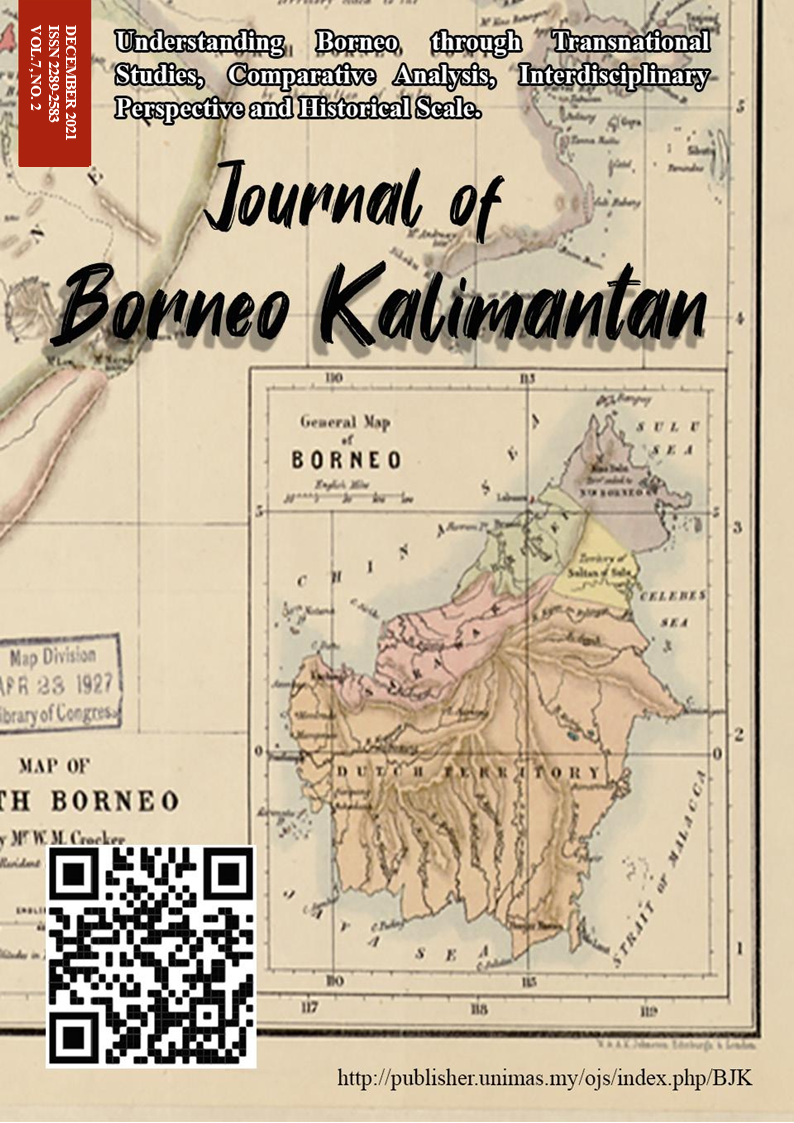
Journal of Borneo Kalimantan
Vol. 7 No. 2 (2021)We are very delighted to share with our readers, Journal of Borneo Kalimantan
(JBK) Volume 7, Issue 2 December 2021.
This issue presents 5 articles that provide analysis of some of the crucial roles of ideas in shaping societal development, social structures, organizations and transformations at different levels in Borneo-Kalimantan.We are also extremely pleased to share 2 book reviews: A Young Muslim’s Guide to the Modern World by Mohd. Shazani Bin Masri and Negeri Santubong (300ESS – 1674ES) by S. Ahmad.
We wish to express our sincere gratitude to all our contributors and reviewers of all the articles and book reviews.
To all readers, Happy Reading and a Happy New Year 2022!Dr Poline Bala
Associate Professor
Institute of Borneo Studies
Universiti Malaysia Sarawak (UNIMAS) -

Journal of Borneo Kalimantan
Vol. 7 No. 1 (2021)It is our honour to present Journal Borneo Kalimantan (JBK) volume 7 Issue 1. Building on the themes of mobility in Borneo-Kalimantan, five articles had been selected for this issue. The first two articles, ethno historical in nature, provide examples of ways in which over time and space, objects and peoples move across Borneo’s physical and social terrains. The first article by Valerie Mashman depicts how a shield – given as a ‘gift’ becomes a circulated object that gathered meanings as it moved from the hand of a chief in Borneo to be found exhibited in the Vatican Museum some 120 years later. The second article, A.W .Nieuwenhuis Merentasi Borneo 1894-1924, the Malay translation of A.W. Nieuwenhuis Across Borneo 1894-1924 by Professor Bernard Sellato is an account of high-profile scientific expeditions made by pioneer Dutch explorers across the terrain of Kalimantan at the turn of the 20th century. Capturing the themes of the ‘comings and goings’ of peoples across porous political boundaries, the next two articles touch on livelihood strategies amongst migrants. Dr Taberdo’s article provides additional empirical understanding to the nature of peoples’ movement within circular migration. Meanwhile, the article by Lumayag et al highlights the quandary of second generation of stateless and undocumented immigrants born in Sabah. Their findings suggest that temporary or ad-hoc access to education remains a palliative route without social inclusion of immigrants into the mainstream society. The final article by Huffer et al, succinctly describes how the identification of recently modified Dayak ‘trophy skull’ through an osteological assessment has revealed that these skulls have morph in different forms as itinerant objects within newer online trade in human remains.
In addition, we are extremely pleased to unveil our Book Review portion in this issue. To kickstart the section, Mohd. Shazani Bin Masri reviews Nafahat Al-Ridwan: Riwayat Hidup Shaykh ‘Uthman Sarawak By Shaykh Muhammad Zayn Al-Din Bin Shaykh ‘Uthman Al-Sarawaqi Translated, Edited And Introduction By Fazril Salleh.
Happy Reading!
JBK Editorial Team
-
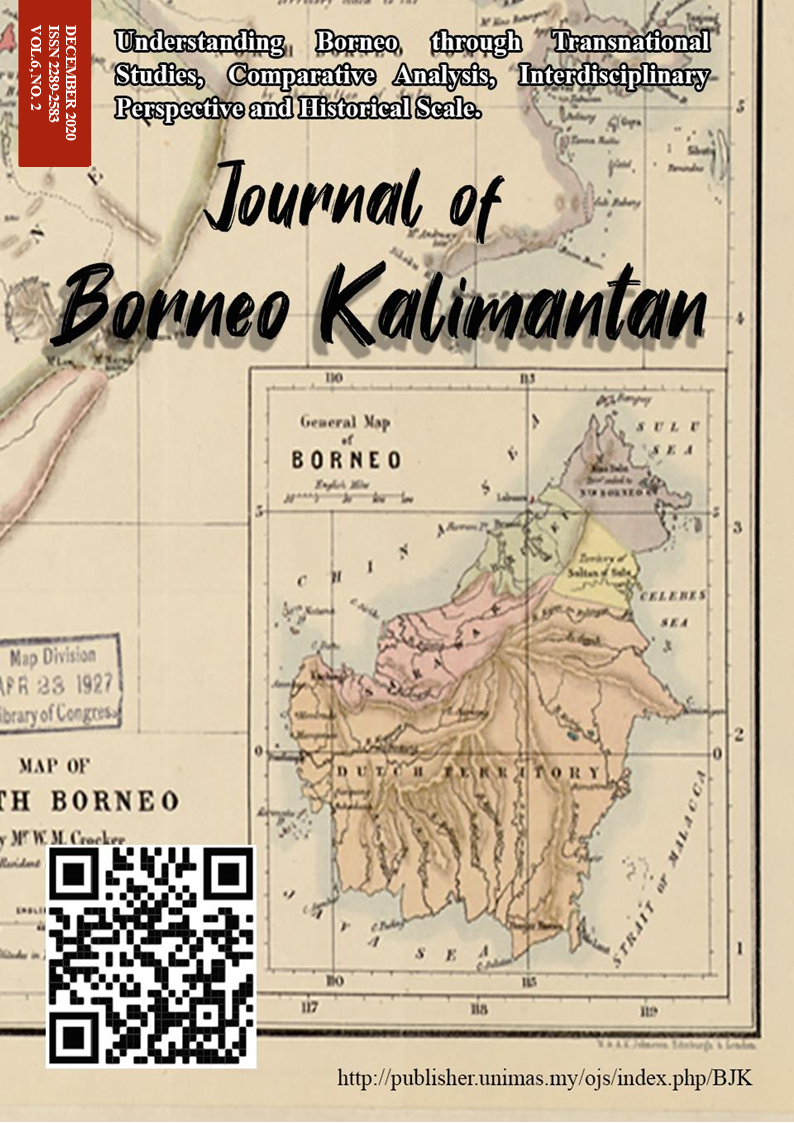
Journal of Borneo Kalimantan
Vol. 6 No. 2 (2020)This present and the next issue of Journal of Borneo-Kalimantan’s theme is mobility of and on the island of Borneo. The theme reflects a perspective commonly used to identify and offer insights into patterns of transformation and social change amongst the societies of Borneo-Kalimantan. As a theme, it addresses movements and circulation of people, cultures, goods, language, images, information, labour, objects, organism and ideas across the island. Volume 6, Issue 2 (2020) presents articles that provide analysis of some of the crucial aspects of mobility that reflect societal experiences, social structures, organizations and transformations at different levels in Borneo-Kalimantan.
We wish to express our gratitude for the permission granted by Dr Pierre Le Roux of Institut d’ethnologie, Universite de Strasbourg for Journal of Borneo-Kalimantan to republish in a Malay translation the original chapter cited as Sellato, B. (1993). “Salt in Borneo.” In P. le Roux and J. Ivanoff (Eds.), Le Sel de la vie en Asie du Sud-Est. Prince of Songkla University. Thank you.
To all readers, Happy Reading and Happy New Year 2021!
Dr Poline Bala
Associate Professor
Chief Editor, Journal of Borneo Kalimantan -
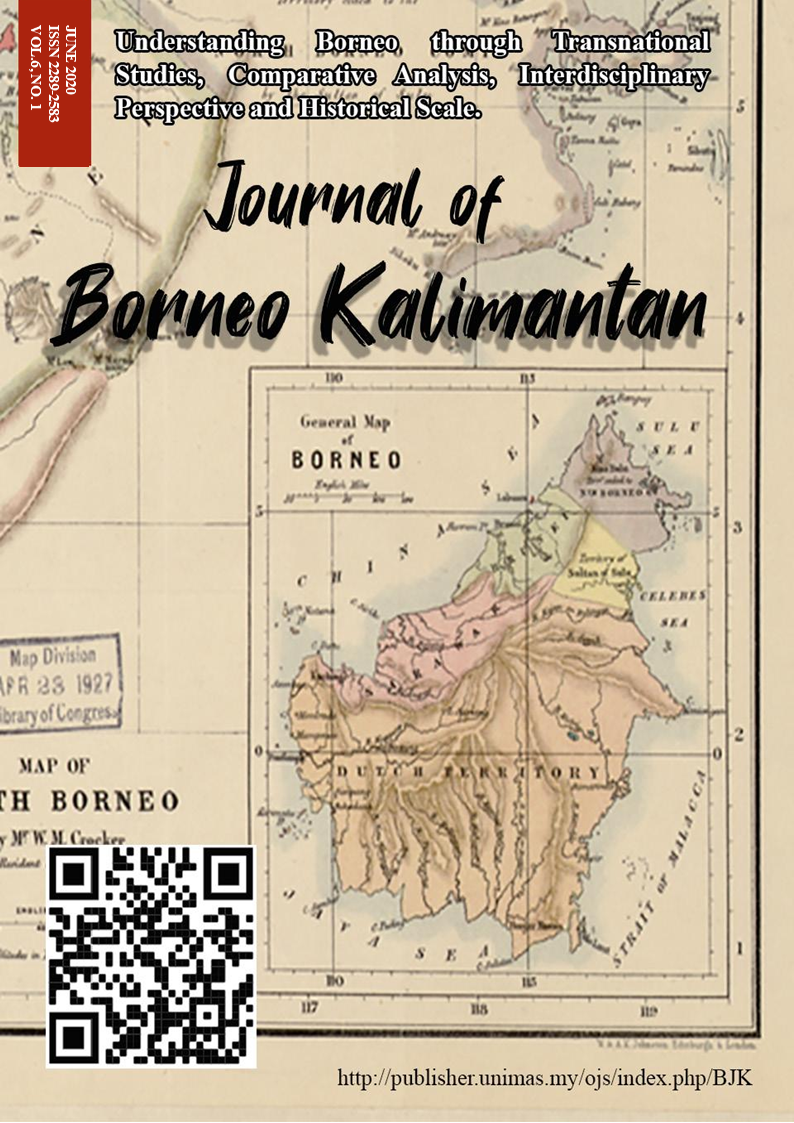
Journal of Borneo-Kalimantan
Vol. 6 No. 1 (2020)This sixth volume, No.1 of Journal of Borneo -Kalimantan (JBK) presents five papers from the island of Borneo. The first paper titled One Orthography, Four Lects: The Unified Berawan Orthography is co-authored by Jurgen Martin Burkhardt, Jey Lingam Burkhardt and Ang Lay Hoon. It alludes to why and how the Berawan community, who desire to write their lects consistently and reflecting the way they speak, attempts a unified orthography to the Berawan language. Written by Irfan Setiawan, Muh Ilham and M. Nawawi, the second paper on Smart Governance Implementation in Balikpapan in East Kalimantan is a descriptive assessment of the application of smart city concept in the running of Balikpapan city. It proposes for the strengthening of local government resources for the mechanism to be effective. The third paper by Jayl Langub titled Masyarakat Melayu di Belaga: Sejarah, Perdagangan, Penempatan dan Adaptasian (translated by Shahren Ahmad Zaidi Adruce) is a detailed ethnographic and historical account of the Malay in Belaga, focusing on their involvement in trade, their settlement and adaptation in the region. Here we would like to acknowledge Borneo Research Bulletin for granting us permission to republish this paper in Bahasa Malaysia, which has been translated from the original appearance as "The Malay of Belaga: History, Trade, Settlement and Adaptation" in the Borneo Research Bulletin 49 (2018): 64-101. The fourth paper by Valerie Mashman brings into the spotlight a local chief named Penghulu Tama Bulan Wang, who played a crucial and critical role in the pacification of Baram. Her account provides nuances to existing historical accounts of peace-making as a means to the formation of the modern state of Sarawak . Last but not least is, Revisiting early Political History of Modern Sarawak through the making of Stephen Kalong Ningkan as Sarawak’s first Chief Minister. Authored by Stanley Bye Kadam and Dick Lembang, the article narrates a political story of modern Sarawak from 1961 to 1974. The historical account throws light on the political struggles of Stephen Kalong Ningkan, who was the State’s first Chief Minister of Sarawak, and the issues affecting his political leadership. They argue that without revisiting his ideas and political struggles, accounts of early history of modern Sarawak is not complete.
Happy Reading!
Poline Bala, PhD (Camb.)
Chief Editor
Journal of Borneo-Kalimantan -

Journal of Borneo-Kalimantan
Vol. 5 No. 1 (2019)A peer-reviewed and multidisciplinary journal on transforming communities in Borneo-Kalimantan and developing regions.
-

Journal of Borneo-Kalimantan
Vol. 4 No. 2 (2018)A peer-reviewed and multidisciplinary journal on transforming communities in Borneo-Kalimantan & developing regions.
-

Journal of Borneo-Kalimantan
Vol. 4 No. 1 (2018)A peer-reviewed and multidisciplinary journal on transforming communities in Borneo-Kalimantan & developing regions.



